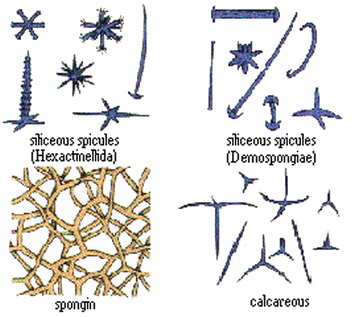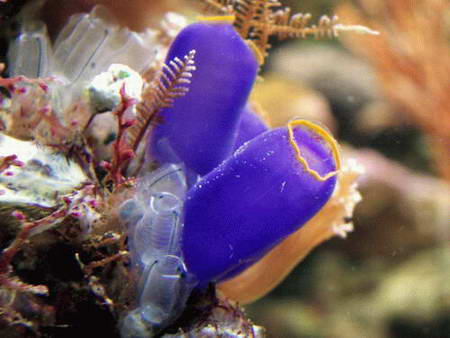
Sponge bodies are diverse in form, ranging from encrusting sheets, to
volcano-shaped mounds, to tubes as small as one millimeter or as large as one
meter. In all cases, sponges have a canal system, through which they pump water. Water enters
through pores called ostia, flows through canals to a spacious chamber called a
spongocoel, and finally exits through large openings called oscula.
Often, sponges are distinguished by the level of complexity
exhibited by their bodies. The simplest form consists of a single tube
two cell layers thick. Sponges with this type of architecture are
necessarily very small due to surface area to volume constraints. In
order for a sponge to attain greater size, the sponge wall
must fold in on itself.
Like cnidarians (jellyfish, etc.) and ctenophores (comb jellies), and
unlike all other known metazoans, sponges bodies consist of a
non-living jelly-like mass sandwiched between two main layers of cells.
Cnidarians and ctenophores have simple nervous systems, and their
cell layers are bound by internal connections and by being mounted on a
basement membrane (thin fibrous mat, also known as "basal
lamina"). Sponges have no nervous systems, their middle
jelly-like layers have large and varied populations of cells, and some
types of cell in their outer layers may move into the middle layer and
change their functions.
Most sessile or slow moving animals on tropical reefs have developed
the means in which to produce a wide array of chemical compounds for
self defense or to prevent other organisms from growing upon
themselves. The brightly colored Nudibranch are a good example of
an animal group that not only produces toxic, defensive compounds, but
advertises that they do by being brightly colored. While many
sponges do not advertise their toxicity through colorfull displays,
they can and do produce some of the most elaborate compounds found
anywhere on the world's reefs. For many years now, science has
been collecting and analyzing a great many sponge compounds for use in
the medical field to combat human cancers and for their use as
antibacterials. It is also thought that many of these compounds
may be used by the sponges as a form of chemical warfare (allelopathic)
against other encrusting or encroaching organisms including other
sponge species. This is where sponges can become a real problem in our
aquariums should they feel the need to defend themselves or die and
cause the release of these compounds. Which could of course cause
the rapid demise of the other organisms we are trying to keep as part
of our captive reef ecosystems. A number of times I have
collected specific sponges with the thought of adding them to my
aquarium only to find that they had released some form of toxin while
in my collection bucket on the way home from our local reef which
promptly killed any and all other creatures that I had collected and
were sharing the same bucket. Over time and through trial and
error I have come to learn which types or species are not prone to
cause such harm and will try to include photos of those that I have
found to be suitable for collection and keeping within an aquarium.


 Sponge bodies are diverse in form, ranging from encrusting sheets, to
volcano-shaped mounds, to tubes as small as one millimeter or as large as one
meter. In all cases, sponges have a canal system, through which they pump water. Water enters
through pores called ostia, flows through canals to a spacious chamber called a
spongocoel, and finally exits through large openings called oscula.
Sponge bodies are diverse in form, ranging from encrusting sheets, to
volcano-shaped mounds, to tubes as small as one millimeter or as large as one
meter. In all cases, sponges have a canal system, through which they pump water. Water enters
through pores called ostia, flows through canals to a spacious chamber called a
spongocoel, and finally exits through large openings called oscula.
 There are four different types of sponges from different
classes: Calcarea, Hexactinellida, Demospongiae, and Sclerospongiae.
They are split into the classes based on the type of spicules they
have. This is an important fact when considering the sponge
species we are attempting to keep within an aquarium setting as the
materials needed, such as silicon, will need to be present in its
dissolved form within the water in order for the sponge to create new
spicules needed for support during growth.
There are four different types of sponges from different
classes: Calcarea, Hexactinellida, Demospongiae, and Sclerospongiae.
They are split into the classes based on the type of spicules they
have. This is an important fact when considering the sponge
species we are attempting to keep within an aquarium setting as the
materials needed, such as silicon, will need to be present in its
dissolved form within the water in order for the sponge to create new
spicules needed for support during growth.  Sponges are made of four simple and independent cells. The first are
the collar cells, which line the canals in the interior of the sponge.
Flagella are attached to the ends of the cells and they help pump water
through the sponge’s body. By pumping water, they help bring
oxygen and nutrients to the sponge while also removing waste and carbon
dioxide. It is when we expose sponges to air that causes many of their
deaths during transport into our aquariums as the flagella are unable
to perform in trapped air bubbles within the sponge, kind of like
trying to row a boat by keeping the oar out of the water. Such
exposure causes the death of the surrounding cells which can lead to
necrotic tissue spreading untill all cells are affected.
Sponges are made of four simple and independent cells. The first are
the collar cells, which line the canals in the interior of the sponge.
Flagella are attached to the ends of the cells and they help pump water
through the sponge’s body. By pumping water, they help bring
oxygen and nutrients to the sponge while also removing waste and carbon
dioxide. It is when we expose sponges to air that causes many of their
deaths during transport into our aquariums as the flagella are unable
to perform in trapped air bubbles within the sponge, kind of like
trying to row a boat by keeping the oar out of the water. Such
exposure causes the death of the surrounding cells which can lead to
necrotic tissue spreading untill all cells are affected. 




